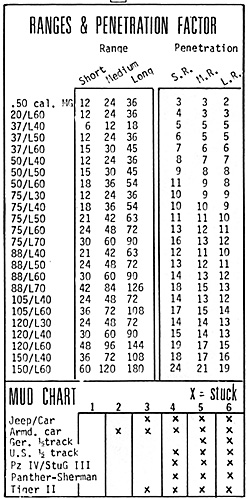
These two situations could he used with just about any set of WW II rules. However, they were designed for use with our local cross between FAST RULES and TRACTICS sometimes called FASTICS, but more commonly HALFAST RULES. These are still evolving but I'll pass on to you a few interesting features.
Feeling that FAST RULES does not sufficiently allow for the different characteristics of different AFVs, first we have each AFV an armor factor for front, flank, rear and top. One factor represents 10mm of armor (fractions less than that are dropped, others are rounded up). Well-sloped armor should be given a 10-20% bonus. Of course the thickness of armor on turret, hull, suspension, etc. is averaged tonether.
Secondly, each caliber and length of gun is rated for range and how many factors of armor it can penetrate at close, medium and long range. (close range being one third of long range, and medium range two thirds). When one tank (or anti-tank gun) fires on another, use the normal AT RULES procedure to determine a hit, with a bonus of 1 on the die roll for close range or a penalty of 1 for long range (greater than medium). If the target was hit then the question is whether or not the target is destroyed. Start with the penetrating power of your gun at the appropriate range, add a constant of 2 (because that's the smallest number you can roll on 2 dice) and subtract the armor factor of the part of the target your shot will hit.
For instance: your gun's penetration is 10, plus 2 equals 12. You're firing at the front of a Panzer IV H which has 8 factors of frontal armor. That leaves 4. Now you roll two dice and if the total rolled is equal to or less than that, the target is destroyed. In this case 2,3 or 4 will destroy it, anything more will bounce off. This system allows for the basic tactic of shooting up enemy tanks where they're weakest - in the flanks and rear, or even better, on top. Also it allows for realistic differentiation between various types of tanks. No lonqer are all medium tanks the same. Yet it does not bog down play with detailed determination of exactly what part of the tank is hit, which crew members were wounded and which ones escaped, etc. Actually we're now trying out a modification of this system using far more range categories, but that's another article.
More WWII Delaying Actions
Back to Table of Contents -- Panzerfaust #62
To Panzerfaust/Campaign List of Issues
Back to MagWeb Master Magazine List
© Copyright 1974 by Donald S. Lowry
This article appears in MagWeb (Magazine Web) on the Internet World Wide Web. Other military history articles and gaming articles are available at http://www.magweb.com